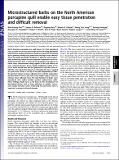Microstructured barbs on the North American porcupine quill enable easy tissue penetration and difficult removal
Author(s)
Cho, Woo-Kyung; Ankrum, James Allen; Guo, Dagang; Chester, Shawn Alexander; Yang, Seung Yun; Campbell, Georgina A.; Wood, Robert J.; Rijal, Ram K.; Karnik, Rohit; Langer, Robert; Karp, Jeffrey Michael; Kashyap, Anurag, M. Eng. Massachusetts Institute of Technology; ... Show more Show less
DownloadCho-2012-Microstructured Barbs on the North American Porcupine Quill Enable Easy Tissue Penetration and Difficult Removal.pdf (993.5Kb)
PUBLISHER_POLICY
Publisher Policy
Article is made available in accordance with the publisher's policy and may be subject to US copyright law. Please refer to the publisher's site for terms of use.
Terms of use
Metadata
Show full item recordAbstract
North American porcupines are well known for their specialized hairs, or quills that feature microscopic backward-facing deployable barbs that are used in self-defense. Herein we show that the natural quill’s geometry enables easy penetration and high tissue adhesion where the barbs specifically contribute to adhesion and unexpectedly, dramatically reduce the force required to penetrate tissue. Reduced penetration force is achieved by topography that appears to create stress concentrations along regions of the quill where the cross sectional diameter grows rapidly, facilitating cutting of the tissue. Barbs located near the first geometrical transition zone exhibit the most substantial impact on minimizing the force required for penetration. Barbs at the tip of the quill independently exhibit the greatest impact on tissue adhesion force and the cooperation between barbs in the 0–2 mm and 2–4 mm regions appears critical to enhance tissue adhesion force. The dual functions of barbs were reproduced with replica molded synthetic polyurethane quills. These findings should serve as the basis for the development of bio-inspired devices such as tissue adhesives or needles, trocars, and vascular tunnelers where minimizing the penetration force is important to prevent collateral damage.
Date issued
2012-12Department
Massachusetts Institute of Technology. Institute for Medical Engineering & Science; Whitaker College of Health Sciences and Technology; Harvard University--MIT Division of Health Sciences and Technology; Massachusetts Institute of Technology. Department of Mechanical EngineeringJournal
Proceedings of the National Academy of Sciences
Publisher
National Academy of Sciences (U.S.)
Citation
Cho, W. K., J. A. Ankrum, D. Guo, S. A. Chester, S. Y. Yang, A. Kashyap, G. A. Campbell, et al. “Microstructured barbs on the North American porcupine quill enable easy tissue penetration and difficult removal.” Proceedings of the National Academy of Sciences 109, no. 52 (December 26, 2012): 21289-21294.
Version: Final published version
ISSN
0027-8424
1091-6490